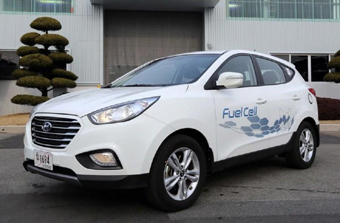
Photo courtesy of Hyundai Motor Company
Hydrogen's Promise, Hydrogen's Hype
| published Monday, December 30, 2013 |
By Earl H. Perkins
Thursday Review Associate Editor
Everyone thought electric cars were all the rage, but hydrogen vehicles could pass them by and become our transportation of the future, according to the Associated Press.
Three automakers on two continents recently unveiled hydrogen fuel cell vehicles that could be on U.S. showroom floors by this coming spring. Korea's Hyundai Motor Company hopes to beat everyone to market with its Tucson, a hydrogen-powered small SUV which should also be available for lease. Honda hopes to reach market by 2015, while Toyota promised a mass-produced fuel cell car by 2015 in Japan, by 2016 in the United States.
Unlike electric cars, which can store only enough power for relatively short distances, the range of hydrogen cars rival those of gasoline-powered cars and can be refueled quickly. Safety and reliability concerns have also been addressed, according to industry experts.
Hydrogen's primary downside is that refueling stations are scarce and costly to build, and mass production could take longer than manufacturers claim, i.e. they're trying to generate interest without the ability to deliver in a timely fashion. That way, people will demand the car, and could possibly wait for all the bugs to be worked out, and they won't whine about the price.
Toyota promises a price range of $50,000 to $100,000, with the lower figure being comparable to a Lexus sedan. Battery-powered and hybrid-electric cars (such as Toyota’s Prius) battled conventional gas models through the past decade, but manufacturers continued to research hydrogen fuel cells, according to Paul Mutolo, director of external partnerships for Cornell University Energy Materials Center. Costs and a lack of filling stations is all that stands between the drawing board and you driving hydrogen, he said.
"It's very similar to the kind of behavior that drivers have come to expect from their gasoline cars," he said. A complex chemical process separates electrons and protons in hydrogen gas molecules, and electricity is created when the electrons move toward the positive pole.
"You're literally ripping the electrons from inside the molecule, generating electricity," Mutolo said.
Oxygen is pumped into the system, with water and heat being created when they mix with the hydrogen ions and electrons. A fuel cell produces about one volt of electricity, which means many cells must be stacked in order to create an adequate amount of energy.
Hydrogen costs in the range of $3 for the amount needed to power a car the same distance as a gallon of gas. It will probably take at least 10 years for a significant number of fueling stations to be built across the nation. Manufacturers will almost certainly lose money initially, but costs will likely decrease as precious metals (such as platinum and copper) are reduced in fuel cells.
All the major automakers have been working with fuel-cell technology for decades, hoping to eventually reach the market. Hydrogen-fueling stations are more expensive than electric car charging stations, and hydrogen will need to produced, stored and transferred safely and efficiently, according to Nissan Motor Co. executive Carlos Ghosn.
Former California Governor Arnold Schwarzenegger was one of the politicians who early on embraced hydrogen and fuel cell cars. In the aught years, he boldly predicted that the hydrogen car would be “the car of the future,” but the initial problems in the Golden State were substantial.
Aside from the technological complexity of converting the hydrogen into a usable fuel—without expending more energy than it was worth—was the issue of supply and distribution. A typical petroleum tanker truck can transport thousands of gallons of gas, enough for 700 to 800 routine automobile fill-ups, but a comparable load of hydrogen would power less than 100 cars.
Author Ozzie Zehner has pointed out that hydrogen, like many new technologies, suffers from typical market complexities, including the “chicken-and-egg problem: Why would car companies produce hydrogen vehicles without hydrogen filling stations and why spend billions for an infrastructure without an existing market of hydrogen-vehicle owners waiting to fill-up?”
"Having a prototype is easy,” Nissan’s Ghosn said, “the challenge is mass-marketing." He does not see a fuel cell vehicle reaching market before 2020.
